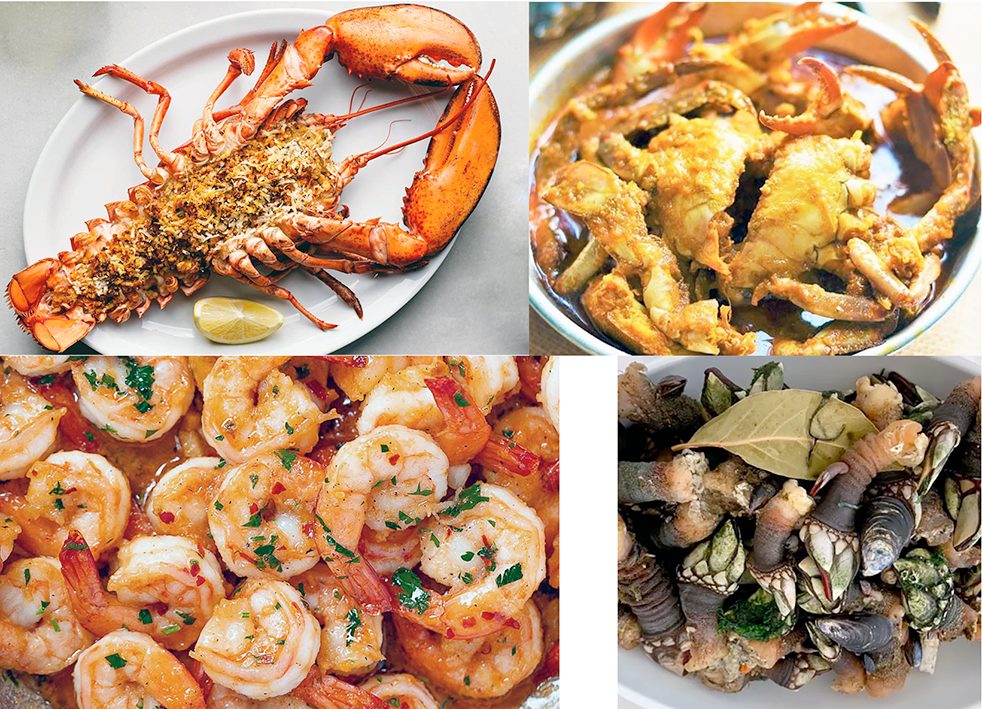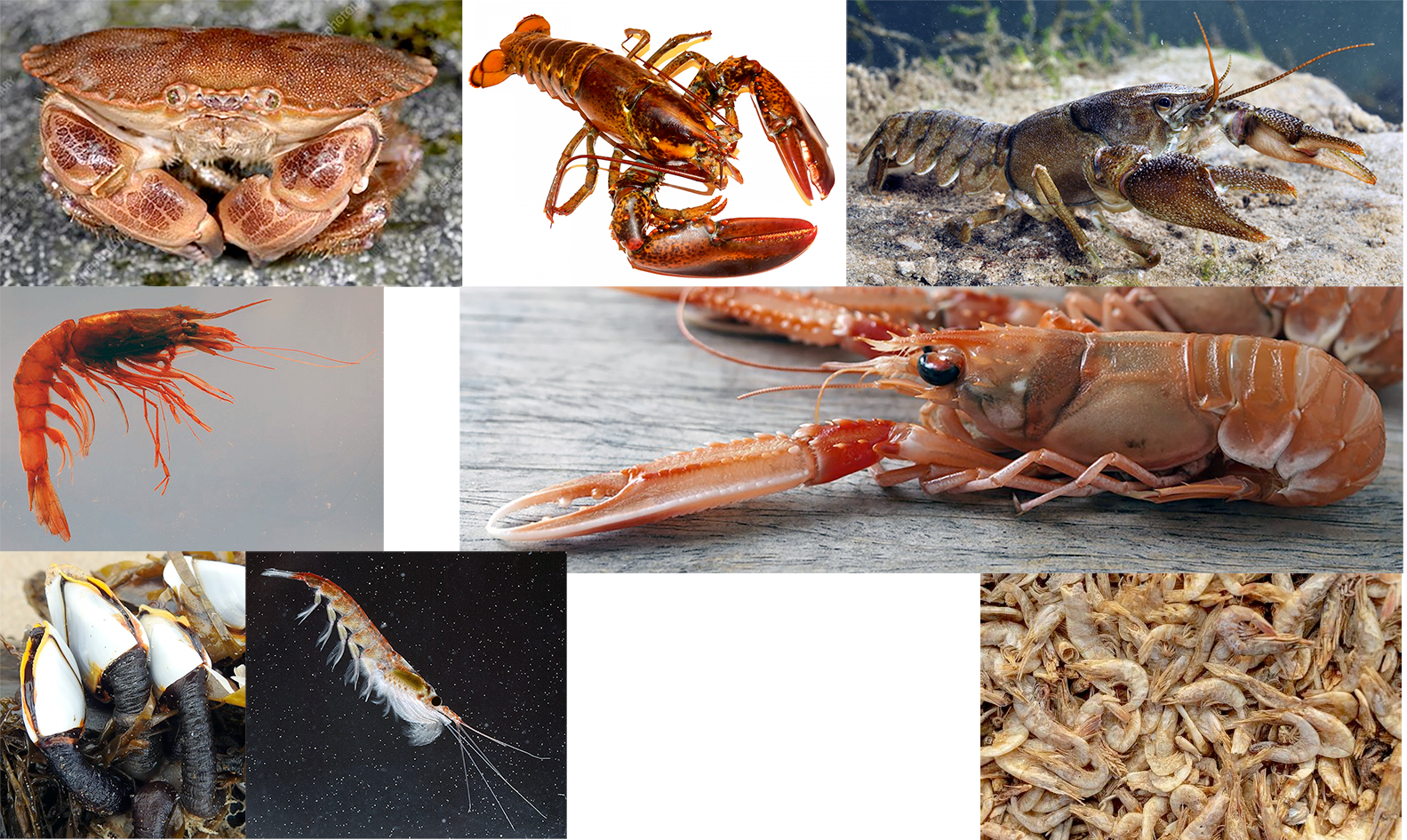FabulousFusionFood's Crustacean-based Recipes 3rd Page
 top: Grilled lobster, crab curry. Bottom: garlic prawns, boiled gooseneck barnacles.
top: Grilled lobster, crab curry. Bottom: garlic prawns, boiled gooseneck barnacles.
Welcome to FabulousFusionFood's Crustacean-based Recipes Page —Crustaceans (from Latin meaning: "those with shells" or "crusted ones") are invertebrate animals that constitute one group of arthropods that are traditionally a part of the subphylum Crustacea (/krəˈsteɪʃə/), a large, diverse group of mainly aquatic arthropods including decapods (shrimps, prawns, crabs, lobsters and crayfish), seed shrimp, branchiopods, fish lice, krill, remipedes, isopods, barnacles, copepods, opossum shrimps, amphipods and mantis shrimp. The crustacean group can be treated as a subphylum under the clade Mandibulata. It is now well accepted that the hexapods (insects and entognathans) emerged deep in the crustacean group, with the completed pan-group referred to as Pancrustacea. The three classes Cephalocarida, Branchiopoda and Remipedia are more closely related to the hexapods than they are to any of the other crustaceans (oligostracans and multicrustaceans).
Most crustaceans are free-living aquatic animals, but some are terrestrial (e.g. woodlice, sandhoppers), some are parasitic (e.g. Rhizocephala, fish lice, tongue worms) and some are sessile (e.g. barnacles). The group has an extensive fossil record, reaching back to the Cambrian. More than 7.9 million tons of crustaceans per year are harvested by fishery or farming for human consumption, consisting mostly of shrimp and prawns. Krill and copepods are not as widely fished, but may be the animals with the greatest biomass on the planet, and form a vital part of the food chain. The scientific study of crustaceans is known as carcinology (alternatively, malacostracology, crustaceology or crustalogy), and a scientist who works in carcinology is a carcinologist.
 top l to r: edible brown crab, lobster. crayfish/crawfish; centre l to r: prawn/shrimp. langoustine;
top l to r: edible brown crab, lobster. crayfish/crawfish; centre l to r: prawn/shrimp. langoustine;bottom l to r: gooseneck barnacle, krill and West African dried prawns.
The name "crustacean" dates from the earliest works to describe the animals, including those of Pierre Belon and Guillaume Rondelet, but the name was not used by some later authors, including Carl Linnaeus, who included crustaceans among the "Aptera" in his Systema Naturae. The earliest nomenclatural valid work to use the name "Crustacea" was Morten Thrane Brünnich's Zoologiæ Fundamenta in 1772, although he also included chelicerates in the group.
The traditional classification of Crustacea based on morphology recognised four to six classes. Bowman and Abele (1982) recognised 652 extant families and 38 orders, organised into six classes: Branchiopoda, Remipedia, Cephalocarida, Maxillopoda, Ostracoda, and Malacostraca. Martin and Davis (2001) updated this classification, retaining the six classes but including 849 extant families in 42 orders. Despite outlining the evidence that Maxillopoda was non-monophyletic, they retained it as one of the six classes, although did suggest that Maxillipoda could be replaced by elevating its subclasses to classes. Since then phylogenetic studies have confirmed the polyphyly of Maxillopoda and the paraphyletic nature of Crustacea with respect to Hexapoda. Recent classifications recognise ten to twelve classes in Crustacea or Pancrustacea, with several former maxillopod subclasses now recognised as classes (e.g. Thecostraca, Tantulocarida, Mystacocarida, Copepoda, Branchiura and Pentastomida).
Many crustaceans are consumed by humans, and nearly 10,700,000 tons were harvested in 2007; the vast majority of this output is of decapod crustaceans: crabs, lobsters, shrimp, crayfish, langoustine and prawns. Over 60% by weight of all crustaceans caught for consumption are shrimp and prawns, and nearly 80% is produced in Asia, with China alone producing nearly half the world's total. Non-decapod crustaceans are not widely consumed, with only 118,000 tons of krill being caught, despite krill having one of the greatest biomasses on the planet. Krill are, however, a speciality in China and Japan and are used pickled in Korea. They are also consumed in Artic regions and are being introduced to new consumers as fusion recipes using frozen and tinned krill. Gooseneck barnacles (Pollicipes pollicipes) are a speciality of Spanish cuisine (recipes including krill and gooseneck barnacles can be found in the links below). The Pacific goose barnacle, Pollicipes elegans is also consumed, particularly in Alaska. The Japanese goose barnacle, Capitulum mitella is eaten in Japan. The Chilean giant barnacle or picoroco (Austromegabalanus psittacus) is routinely fished for food. Woodlice are sometimes consumed by foragers. Dried prawns (locally known as crawfish) are used as a flavouring and thickener in West African stews.
The alphabetical list of all the Crustacean-based recipes on this site follows, (limited to 100 recipes per page). There are 550 recipes in total:
Page 3 of 6
| Feuilles de Manioc Malienne (Malian Cassava Leaf Stew) Origin: Mali | Guyanese Crab Callaloo Origin: Guyana | Katakou au Poisson Frais (Palm Soup Base with Fresh Fish) Origin: Cote dIvoire |
| Fijian Crab Curry Origin: Fiji | Haiken (Chicken and Prawn Egg Rolls) Origin: Mauritius | Ke'lagu'en Uhang (Prawns and Peppers) Origin: Guam |
| Filé Gumbo Origin: Louisiana | Hami (Fermented Coconut Sauce) Origin: Tonga | Ke'lagu'en Uhang (Prawns and Peppers) Origin: Northern Mariana Islands |
| Filipino Fish Curry Origin: Philippines | Herb and Garlic Prawns Origin: Britain | Kedjenou Origin: Cote dIvoire |
| Fish Creole Origin: Louisiana | Honey-glazed Prawns Origin: Roman | Kejenou avec Agouti (Kejenou with Cane Rat) Origin: Cote dIvoire |
| Fish Kebabs Origin: Britain | Hong Kong Curry Fish Balls Origin: Hong Kong | Kelenkelen (Fish with Cassava Leaves) Origin: Cameroon |
| Fish Pie with Dulse Origin: Scotland | Ikan Assam Pedas (Hot-and-sour Fish Stew) Origin: Malaysia | Khayan thee Hnat (Burmese Stuffed Aubergine Curry) Origin: Myanmar |
| Fish Sausages Origin: Scotland | In Locusta Elixa (Sauce for Boiled Lobster) Origin: Roman | Khichiri Prawn Sauce Origin: India |
| Fisk och paprikasoppa (Fish and Bell Pepper Soup) Origin: Sweden | Indonesian Peanut Sauce Origin: Indonesia | King Prawn Pathia Origin: Britain |
| Flancitos Origin: Chile | Isicia de Cauda Eius sic Facies (Make Lobster Tail Forcemeat Balls Thus) Origin: Roman | Kingklip and Prawn Biryani Origin: South Africa |
| Folon Origin: Cameroon | Isicia de scillis (Prawn Rissole) Origin: Roman | Kiribati Coconut Crab Curry Origin: Kiribati |
| Foufou de Banane à la Sauce Claire (Plantain Fufu with Clear Sauce) Origin: Mali | Isicia Marina (Seafood Patties) Origin: Roman | Kontomire Stew (Cocoyam Leaf Stew) Origin: Ghana |
| French Coconut Fish Curry Origin: France | Iwuk Efere Origin: Nigeria | Korean-inspired Pollock Stew with Gochujang and Wild Greens Origin: Korea |
| Fricassé de ouassous (Fricassée of Freshwater Prawns) Origin: Guadeloupe | Jamaican Jerk Shirmp Origin: Jamaica | Kouti (Cassava Croquettes) Origin: Guinea |
| Fried Brinjal Sambal Origin: Myanmar | Jamaican Prawn Curry Origin: Jamaica | Krain Krain (Jute Leaf Stew) Origin: Sierra Leone |
| Fried Kway Teow Origin: Malaysia | Jamaican Rum Prawns Origin: Jamaica | Kreooli krabi-kotletid (Dominican Creole Crab Cakes) Origin: Dominica |
| Fried Kway Teow Origin: Christmas Island | Jamaican Seafood Soup Origin: Jamaica | Kriibsen (Crayfish, Luxembourg Style) Origin: Luxembourg |
| Fried Kway Teow Origin: Cocos Islands | Jambo (Okra Soup) Origin: Bonaire | Krill Sweet Potato Cakes Origin: Fusion |
| Fu Yung Hai (Eggs Fu Yung) Origin: China | Jambo (Okra Soup) Origin: Curacao | Krokèchi (Prawn Croquettes) Origin: Aruba |
| Fukusazushi Origin: Japan | Javaanse Bami Origin: Suriname | Kyet tha Kar la Thar Hin (Chicken and Squash Curry) Origin: Myanmar |
| Gaeng Pa (Jungle Curry Paste) Origin: Thailand | Jungle Curry Prawns Origin: Thailand | Laksa Origin: Malaysia |
| Gaeng Som (Thai Sour Curry) Origin: Thailand | Kaeng Khiao Wan (Thai Green Curry) Origin: Thailand | Laksa Paste Origin: Singapore |
| Gaeng Som (Thai Sour Curry) Origin: Thailand | Kaeng Phet Pet Yang (Thai Red Roast Duck Curry) Origin: Thailand | Laksa Paste Origin: Malaysia |
| Gaeng Som (Thai Sour Orange Curry) Origin: Thailand | Kajaik (Sudanese fish stew) Origin: South Sudan | Laksa Paste II Origin: Malaysia |
| Galician-style Goose Barnacles Origin: Spain | Kakrar Jhal (Bengali Crab Curry) Origin: India | Langouste à la Vanille (Lobsters with Vanilla Sauce) Origin: Comoros |
| Gambas ou langoustines au pastis (Prawns or Langoustines with Pastis) Origin: Monaco | Kansiyé avec 'Mafe' (Smoked Chicken in Peanut Sauce with Mashed Plantains) Origin: Guinea | Langoustes grillées au beurre vanillé (Grilled Lobsters with Vanilla Butter) Origin: New Caledonia |
| Gari aux Crevettes (Gari with Prawns) Origin: Cameroon | Kare Kare Origin: Philippines | Langoustes grillées sauce antillaise (Grilled Spiny Lobster with Antillean Sauce) Origin: Sint Maarten |
| Gari Foto Origin: Ghana | Kari Ikan (Fish Curry) Origin: Malaysia | Langoustes grillées sauce antillaise (Grilled Spiny Lobster with Antillean Sauce) Origin: Saint Barthelemy |
| Ginger Prawns with Oyster Mushrooms Origin: China | Kari Ikan (Malaysian Fish Curry) Origin: Malaysia | Langoustes grillées sauce antillaise (Grilled Spiny Lobster with Antillean Sauce) Origin: Saint-Martin |
| Goan Crab Claw Curry Origin: India | Kari Koko (Seychellois King Prawn and Coconut Curry) Origin: Seychelles | Langoustines bretonnes sautées au beurre salé (Breton langoustines sautéed in salted butter) Origin: France |
| Gratin de fruits de mer (Seafood Gratin) Origin: Monaco | Karko Stobá (Queen Conch Stew) Origin: Aruba | Lao Tam Som (Lao Green Papaya Salad) Origin: Laos |
| Gratin de galettes aux crevettes (Gratin of Pancakes with Prawns and Mushrooms) Origin: France | Karko Stobá (Queen Conch Stew) Origin: Bonaire | Laska Origin: Malaysia |
| Grilled Coconut Crab Origin: Federated States Micronesia | Karko Stobá (Queen Conch Stew) Origin: Curacao | |
| Grilled Coconut Crab Origin: Tuvalu | Karrísúpa (Icelandic Curry Soup) Origin: Iceland |
Page 3 of 6